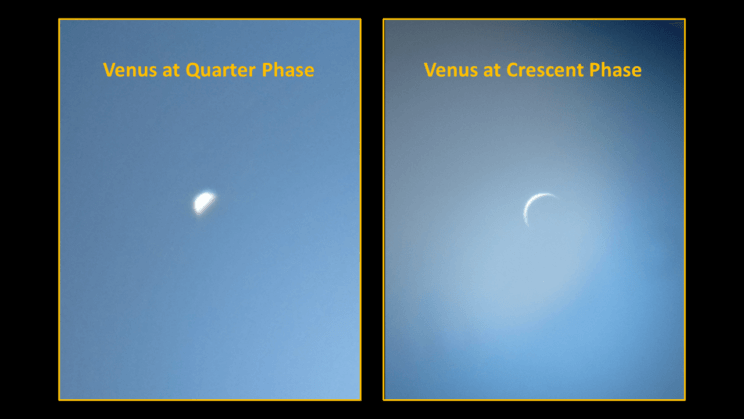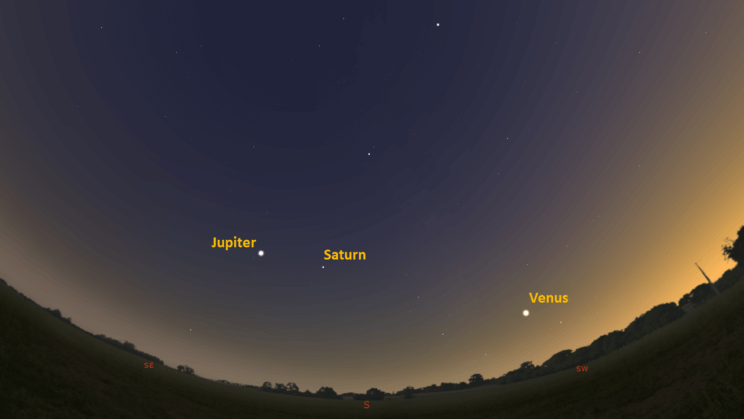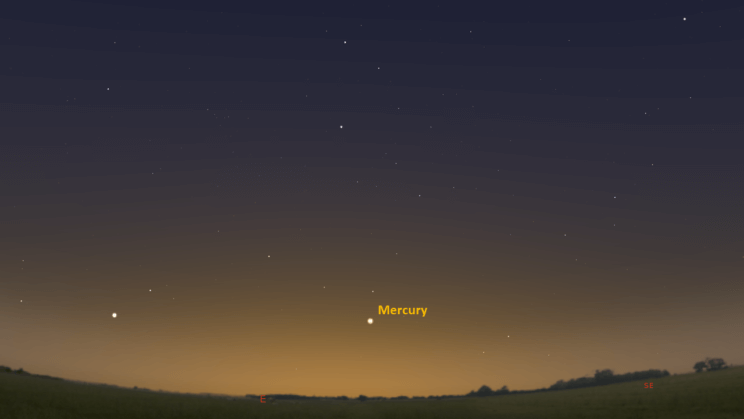This is the Saint Louis Science Center’s NIGHT SKY UPDATE for the week of Friday, October 22, 2021.
Information updated weekly or as needed.
Times given as local St. Louis time, which is Central Daylight Time (CDT). For definitions of terminology used in the night sky update, click the highlighted text. If relying on times posted in Universal Time (UT), St. Louis is -5 hours when CDT.
Public Telescope Viewings
With the changing recommendations from the CDC regarding COVID-19, conversations regarding the return of star parties at the Saint Louis Science Center have begun. We are close to bringing back our public telescope viewings, but a few details still need to be worked out. We will post future updates as we learn more about when we can bring back telescope viewings.
Observing Highlight of the Week

Phased Venus seen during an evening apparition. Notice the angular size changes as the phases do. These images were taken with a cell phone held up to the eyepiece of a telescope. Image credit: Eric Gustafson
This week Venus and Mercury reach greatest elongation. This term refers to when a solar system body is at its maximum angular separation from the Sun. Because Mercury and Venus are closer to the Sun than Earth is, we never see them stray far from the Sun in the sky. Therefore, some have called Mercury and Venus the Morning and Evening Stars because they are often the first star-like objects seen low to the horizon after sunset or before sunrise. The rising or setting of an object during dusk or dawn played a major role in ancient astronomy. The terms used to describe these observations are heliacal when occurring near sunrise and acronical when occurring just after sunset. These kinds of observations were often connected to cultural traditions and the development of calendar systems.
A planet is said to start an apparition once it is visible at night. For inferior planets (Mercury and Venus), they exhibit morning and evening apparitions depending on what side of the Sun, we see them on. For evening apparitions, inferior planets are visible after sunset in the west. When they reach their maximum elongation from the Sun, it is said they are at maximum eastern elongation. Another way to think of this is, during an evening apparition, inferior planets elongate away from the Sun towards the east. For Morning apparitions, inferior planets are seen in the east before sunrise and will reach a maximum western elongation.
Venus typically will reach greatest elongation twice a year, during its two apparitions. Mercury on the other hand will exhibit about 7 apparitions a year owing to it orbiting the Sun once every 88 days. Inferior planets exhibit two apparitions every orbit. Venus orbits the Sun in 224 days which means we see roughly 1.6 Venus apparitions a year. Mercury on the other hand completes a little over four orbits every Earth year. We typically see seven full apparitions of Mercury each year.
Of the two, Venus is by far the easiest to see. It is much brighter than Mercury and it has a greater maximum elongation angle. Currently, Venus is exhibiting an evening apparition which means you will find it in the southwest after sunset. Venus reaches maximum eastern elongation on October 29, 2021. After this date, you will see Venus head back towards the Sun on its way to inferior conjunction. This is when Venus passes between Earth and the Sun. Venus reaches inferior conjunction on January 8, 2021. As get close to this date be careful if looking for Venus. Make absolute sure the Sun has set before you look.
Mercury is currently in a morning apparition. As such, we will see the elusive planet low in the east about 30 minutes before sunrise. Mercury reaches maximum western elongation on October 25, 2021. Mercury is a bigger visual challenge due a much smaller maximum elongation angle. The best apparitions of Mercury occur around mid-March and mid-September. This has to do with when the angle of the ecliptic is seen to be more perpendicular to the horizon. For evening apparitions, the angle of the ecliptic is at its steepest near the spring equinox in the northern hemisphere. For morning apparitions, the angle of the ecliptic is steepest near the autumnal equinox. After Mercury reaches maximum elongation on October 25, 2021, it will begin to head back towards the Sun on its way to superior conjunction. This is when Mercury will pass behind the Sun from our view on Earth.
Lastly, Mercury and Venus both exhibit phases like the Moon. The main difference is we won’t see either planet exhibit a full phase. This is because they are closer to the Sun and as such, they never present a fully illuminated disk when viewed from Earth. When both planets reach maximum elongation, they will exhibit a quarter phase. After this, you will see Venus shift into crescent phases because it is moving towards inferior conjunction. Mercury on the other hand will shift into gibbous phases as it heads toward superior conjunction. The phases of Venus can be seen in binoculars, but the phases of Mercury are better seen through a telescope. As both planets are usually seen close to the Sun, make absolute sure if using an optical instrument that the Sun has set.
The Sun and Moon

The Moon as seen from the International Space Station, on July 31, 2011.
Credit: NASA
Sunrise is at 7:17 a.m. on Friday, October 22 and sunset is at 6:12 p.m. providing us with a bit under 11 hours of daylight. Even after sunset, the light from the Sun will dimly illuminate our sky for roughly 1 hour and 30 minutes. This period is called twilight, which ends around 7:42 p.m. this week. For those with a sundial, local noon occurs around 12:45 p.m. this week.
| Day | Sunrise | Sunset |
|---|---|---|
| 2021-10-22 | 7:17 a.m. | 6:12 p.m. |
| 2021-10-23 | 7:18 a.m. | 6:11 p.m. |
| 2021-10-24 | 7:19 a.m. | 6:10 p.m. |
| 2021-10-25 | 7:20 a.m. | 6:09 p.m. |
| 2021-10-26 | 7:21 a.m. | 6:07 p.m. |
| 2021-10-27 | 7:22 a.m. | 6:06 p.m. |
| 2021-10-28 | 7:23 a.m. | 6:05 p.m. |
| 2021-10-29 | 7:25 a.m. | 6:04 p.m. |
| 2021-10-30 | 7:26 a.m. | 6:02 p.m. |
Moon
Moonrise for Friday, October 22 occurred at 7:28 p.m. and moonset will occur at 10:09 a.m. on the following day. On Friday, October 22 the Moon will exhibit a waning gibbous phase with about 96% of the lunar disk illuminated. Last quarter moon occurs on October 28 at 3:05 p.m.
International Space Station (ISS) Observing

Visible passes of ISS from St. Louis for the week of October 22 occur during morning hours. The best pass this week occurs on the morning of October 25. Use the table below for information about this and other visible passes this week.
Catch ISS from St. Louis starting Friday, October 22
| Date | Starts | Max. altitude | Ends | |||||||
|---|---|---|---|---|---|---|---|---|---|---|
| Time | Alt. | Az. | Time | Alt. | Az. | Time | Alt. | Az. | ||
| 24 Oct | -3.1 | 06:14:42 | 25 | W | 06:16:10 | 39 | NNW | 06:19:21 | 10 | NE |
| 25 Oct | -2.7 | 05:29:51 | 41 | NNE | 05:29:51 | 41 | NNE | 05:32:14 | 10 | NE |
| 26 Oct | -2 | 06:17:51 | 17 | NW | 06:18:44 | 19 | NNW | 06:21:13 | 10 | NNE |
| 27 Oct | -1.6 | 05:32:45 | 19 | N | 05:32:45 | 19 | N | 05:34:13 | 10 | NNE |
Magnitude (Mag): The Measure of brightness for a celestial object. The lower the value is, the brighter the object will be.
Altitude (Alt): The angle of a celestial object measured upwards from the observer’s horizon.
Azimuth (Az): The direction of a celestial object, measured clockwise from an observer’s location with north being 0°, east being 90°, south being 180° and west being 270°.
For information about ISS flyovers and other visible satellites, visit www.heavens-above.com
Detailed information regarding all unmanned exploration of our universe, missions past, present, and planned, can be found at Jet Propulsion Laboratories:
The Visible Planets

Looking South, at 6:40 p.m. October 23, 2021. Credit: Stellarium, EG

Looking east, at 6:40 am, October 25, 2021. Credit: Stellarium, EG
This week, three naked eye planets are visible. Venus can be found in the west after sunset. Jupiter and Saturn can be found in the southeast after sunset. Mercury is visible in the east before sunrise.
Mercury
Mercury is rising this week about 1.5 hours before the Sun. As such, early birds might catch a glimpse of the elusive planet about 30 or 40 minutes before sunrise. The catch is you need a clear eastern horizon. At the start of the, your best chance to see Mercury will be about 30 minutes before sunrise when it will be about 10° above the horizon. Mercury reaches greatest western elongation on October 25, 2021. After this date, Mercury will head back towards the Sun. This week is our best chance to spot Mercury this apparition.
Venus
Venus is well into another evening apparition. By 6:32 p.m., Venus will be about 15° above the southwestern horizon. Venus will set at 8:21 p.m. Venus reaches maximum eastern elongation October 29, 2021. After this date Venus will start to head back towards the Sun as it approaches inferior conjunction on January 8, 2022.
Mars
The red planet has not been visible for several weeks now. The previous apparition of Mars has ended. But for those itching to see Mars again, you are in luck as the next apparition of Mars begins in November 2021. This week on October 8, 2021, Mars will be in conjunction with the Sun. Slowly after this date, Mars will climb out of the Sun’s glare eventually becoming visible just before sunrise. The next Mars apparition is expected to begin around November 14, 2021, when Mars will appear far enough from the Sun for safe viewing.
Jupiter
Jupiter has passed opposition and as such will be visible about 30 minutes after sunset. Look for Jupiter in the south as it starts to darken outside. Jupiter sets at 1:42 a.m. tomorrow morning and will set about 30 minutes earlier each week. Jupiter reaches superior conjunction on March 5, 2022. This means we can count on seeing Jupiter in the southern skies for the rest of this year and well into 2022.
Saturn
Saturn is past opposition which means it will be visible about 30 minutes after sunset. Right now, it can be found in the south after sunset, but as we continue through the year, Saturn will set about 30 minutes earlier each night. Saturn sets at 12:26 a.m. Saturn will reach superior conjunction on February 4, 2022.
Uranus
Uranus will reach opposition on November 5, 2021, at 0 hrs. UT. For us in St. Louis, that translates to 19:00 or 7:00 p.m. CDT. When near opposition, Uranus can be seen naked eye under dark skies. In St. Louis you will need binoculars to spot this ice giant. Uranus rises at 6:47 p.m. and will be easily found by 9:00 pm in the east in the constellation Aries.
James S. McDonnell Planetarium
Night Sky Update: October 22 – October 30, 2021







